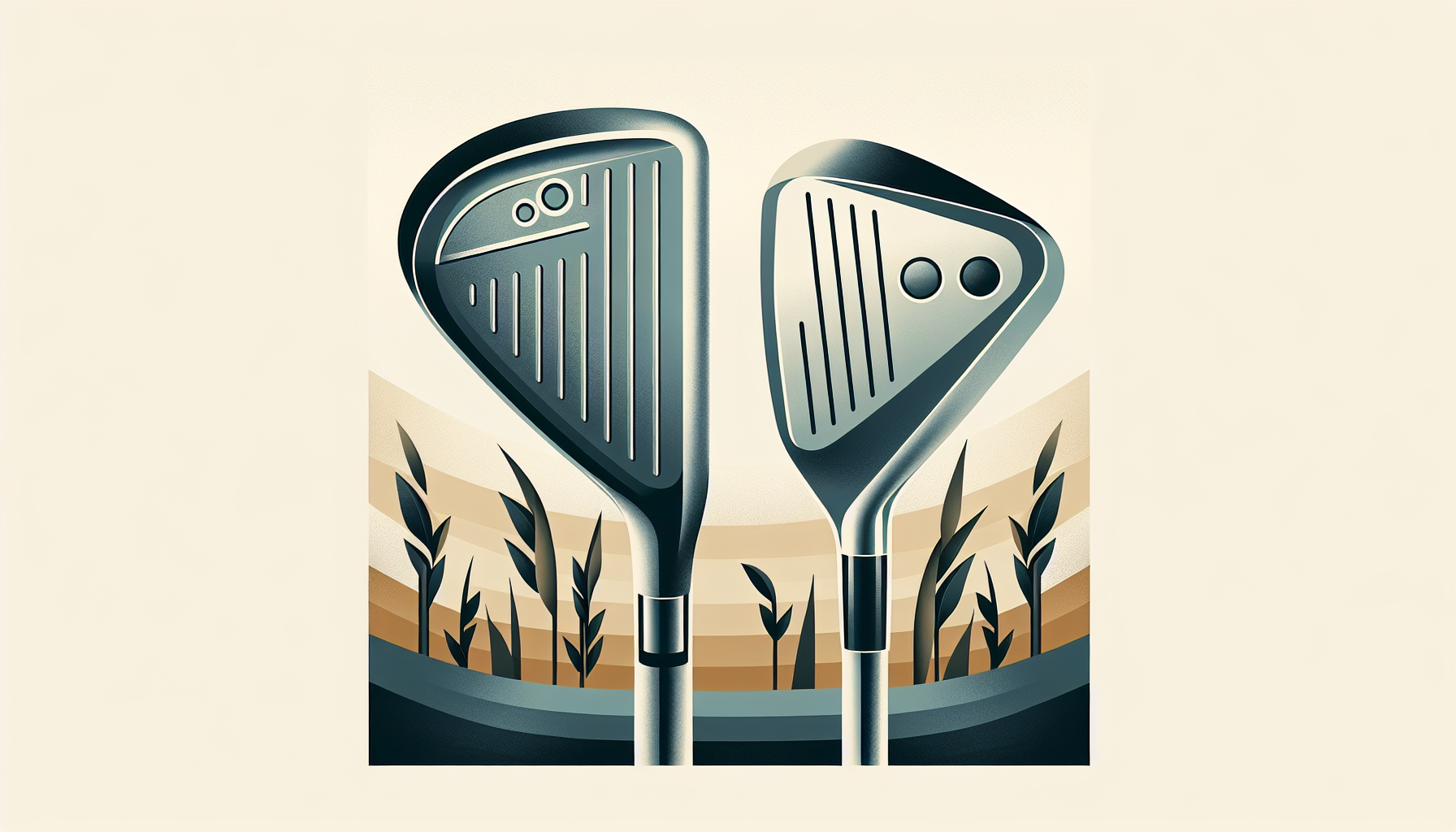Understanding Golf Irons
Starting your golf journey? Well, it’s all about wielding the right gear, and golf irons are as essential as a marshmallow at a campfire. You’ve got two big players in the iron world: the sleek blade and the forgiving cavity back. Let’s dive into what makes them tick so you can pick a winner like you pick your fantasy football team.
Blade Irons Overview
Blade irons, often called muscle backs ’cause they look tough, are the choice of those seasoned pros you see on TV. Their chic, compact look isn’t just for show—it means business. With a tiny sweet spot and shallow cavities, these bad boys require a lot of skill. They keep you honest by sending a not-so-subtle nudge when you don’t hit it just right, especially off the heel or toe. Miss a shot with these, and you’ll know exactly where you went wrong.
| Characteristics | Blade Irons |
|---|---|
| Sweet Spot | Tiny like a fairy’s teacup |
| Forgiveness | Let’s just say you’ll learn |
| Shot Feedback | Honest to a fault |
| Shot Control | Precise as your smart home |
| Difficulty Level | A zillion out of ten for newbies |
Cavity Back Irons Overview
Cavity back irons are the best friends of beginners, no doubt about it. They come with a big ol’ sweet spot, forgiving more mistakes than your grandma. You can whack the ball a bit off-center and it’s still going on vacation, high and far. Thanks to their perimeter weighting, beginners feel like they’ve finally got their act together. It’s like adding training wheels to your bike—before you know it, you’re riding like the wind with confidence.
| Characteristics | Cavity Back Irons |
|---|---|
| Sweet Spot | Inflated, like a party balloon |
| Forgiveness | Like a best friend |
| Shot Feedback | You’ll get the gist |
| Shot Control | Not quite the control freak |
| Difficulty Level | Beginner’s paradise |
Picking your iron is like choosing a partner for the dance floor—it needs to fit your rhythm. Need some more advice? Check out our golf club fitting guide, or if you’re a high handicapper, swing by our best golf clubs for high handicappers to match your style.
Characteristics of Blade Irons
G’day folks! Today, we’re talking golf clubs, specifically those snazzy blade irons. These bad boys have some pretty distinct traits, and if you’re just stepping onto the green, it’s good to know what you’re dealing with. Blade irons aren’t just shiny sticks; they bring a whole different feel compared to their more forgiving counterparts, the cavity back irons.
Precision and Feedback
So, what’s the deal with blade irons? The big kicker is their precision and feedback. Using these clubs, you get a handle on your shot’s journey through the air with a bit more control. Want to bend that ball like Beckham? You’re in luck! Blade irons are the tools for creative shot shaping, like drawing or fading the ball. But here’s the catch – they demand a nice, consistent swing, or you’ll be picking daisies after a wild mishit (Pacific Golf Warehouse).
Another sweet thing about blade irons is the feedback – it’s like they’re telling you exactly where you went wrong. Smack the ball off the heel or toe and you’ll feel it immediately. This level of feedback is a bit more hush-hush with cavity back irons (The Left Rough).
| Characteristic | Blade Irons | Cavity Back Irons |
|---|---|---|
| Control | High | Lower |
| Feedback | Immediate | Less pronounced |
| Suitability for | Seasoned players | Rookies and high handicappers |
Ball Control and Shot Shape
Folks who dig blade irons aren’t just in it for looks—they love the ball control and shot shapes. With these clubs, it’s easier to tweak the ball’s path and find the sweet routes on the course. Thanks to that precise feedback again, fixing up your swing becomes second nature.
According to some chit-chat on the links, when you compare blades to forged cavity back irons, distance isn’t that big of a deal if other things, like loft and swing weight, are squared away (GolfWRX Forums). The real game-changer is how these clubs can boost your shot control, not necessarily your drive distance.
| Feature | Blade Irons | Cavity Back Irons |
|---|---|---|
| Shot shape capabilities | High | Moderate |
| Focus on control | Yes | No |
Getting the lowdown on blade irons can really help newcomers make the right choice with their gear. Want more advice on picking out golf clubs? Swing by our guide on how to choose golf clubs for beginners.
Characteristics of Cavity Back Irons
Cavity back irons have some cool features that make them favorites among golfers. If you’re just dipping your toes into the golfing world, getting to know about these clubs—especially in terms of forgiveness, consistency, distance, and how high they send the ball—is a good start.
Forgiveness and Consistency
One thing that makes cavity back irons stand out is how forgiving they are. Thanks to something called perimeter weighting, these irons have a bigger sweet spot. What does this mean for you? Well, it means you can mess up a little and still get a decent hit. Even when you don’t hit the center perfectly, the ball still ends up going further and straighter. Some folks, like those at Pacific Golf Warehouse, vouch that these irons give extra yards and help you aim better, making you feel like a pro.
| Feature | Cavity Back Irons | Blade Irons |
|---|---|---|
| Sweet Spot Size | Big | Not so big |
| Forgiveness | Lots | Not much |
| Consistency of Hits | High | Depends a lot |
| Moment of Inertia (MOI) | High | Low |
Distance and Trajectory
Another big plus with cavity back irons is the distance and how high they pop the ball up. Their design is all about making the ball fly higher and farther—ideal for beginners trying to get consistent speed and distance on their shots. With improvements over the years, these clubs give a forgiving hit, especially if you’re just starting out.
Now, blade irons, they’re a different beast. They’re fantastic for precise control and shaping your shots if you really know what you’re doing. But they demand a bit more from the player (Pacific Golf Warehouse). If you’re new, cavity backs give you that reliable distance and preferred ball flight and play nice with different swing styles.
In short, if you’re just getting into golf and still figuring out your swing, cavity back irons offer the balance of forgiveness and distance you need to build confidence and skills. Thinking about your first set of clubs? Check out our golf club fitting guide or see the best golf clubs for high handicappers for more tips.
Choosing Between Blade and Cavity Back Irons
Picking the right golf clubs is a bit like picking your pals for a road trip – you want ones that’ll keep things smooth and fun, especially if you’re just starting out. Let’s chat about blades vs. cavity back irons and what might be your best bet if you’re just teeing off, plus see what’s hot among the pros.
Recommendations for Beginner Golfers
For folks new to the golf scene, it’s cavity back irons all the way. These bad boys are super handy because they’re more forgiving. Little wiggles or hiccups in your swing won’t get the best of you. The Left Rough backs this up, saying they can help get your score down faster without driving yourself bonkers. High-handicap golfers (those folks swinging scores over 20) and mid-handicappers (dodging around the 11 to 20 mark) find these clubs easier to handle (Pacific Golf Warehouse).
| Golfer Type | Recommended Clubs | Handicap Score |
|---|---|---|
| Novice (High Handicap) | Cavity Back Irons | Over 20 |
| Novice (Mid Handicap) | Cavity Back Irons | 11 – 20 |
With cavity back irons, newbies can work on getting that swing nice ‘n smooth without getting bogged down by blades that are a bit more finicky.
Professional Trends and Preferences
The pros have gotten a bit trendy, trying out all sorts of combos between blades and cavity backs. Where it was once all about blades, tech advances have cooked up irons that blend the forgiving nature of cavity backs with the sleek styling of blades (The Left Rough). This hybrid style is having its moment, giving pros the best of both worlds for whatever curveballs (or golf balls) the course throws at them.
| Player Category | Preferred Iron Style | What They’re Like |
|---|---|---|
| Pro Golfers | Mixed (Blade & Cavity) | Forgiving with the classic feel |
| Low-Handicap Pros | Blade Irons | Made for accuracy, typically in the 1 – 10 score range (Pacific Golf Warehouse) |
This trend shows how pros are getting creative with their gear, tweaking their bag contents to suit their exact style and different courses. So, if you’re a newbie pondering which clubs to clasp your hands around, be sure to swing by our handy golf club fitting guide for more pro tips on selecting clubs that play to your strengths.
Factors Influencing Iron Selection
Picking the right clubs is crucial for newbies in golf. Things like tech upgrades in club design alongside how good you are at swinging those beauties can really steer you towards choosing either blade or cavity back irons.
Technology Advancements
Golf tech is like a roller coaster — accelerating every year. Cavity back irons have stepped up their game with increased forgiveness, yet they still give you that sweet feel. Even the pros these days mix things up by using both blade and cavity back irons. It’s kind of like ordering a combo meal — get the forgiveness from cavity backs and the precise feedback from blades (The Left Rough).
Thanks to inventions like Trackman, players can now break down their swings like a math equation. This tech lets them focus on data-driven decisions instead of just winging it. As clubs get snazzier, you might find the lines between the two types of irons getting fuzzier, meaning more versatile choices are hitting the market.
Skill Levels and Handicap Ranges
Your skill level and handicap can put the brakes on or rev up which irons you grab. Blades are mostly for those golf maestros — think of a USGA handicap index from 1 to 10. These folks make golf look like chopsticks and drumsticks — precise and smooth, and they score near par more often than not.
Then you’ve got cavity back irons, perfect for the weekend warriors or those finding their swing. They’re super forgiving, almost like having a golf guardian angel for when you whiff. Even some seasoned pros take comfort in these forgiving clubs because they cover up slip-ups and keep shots more consistent (Pacific Golf Warehouse).
| Skill Level | Recommended Iron Type | USGA Handicap Index |
|---|---|---|
| Beginner | Cavity Back Irons | 10+ |
| Intermediate | Cavity Back Irons | 5 to 10 |
| Advanced | Blade Irons | 1 to 5 |
So when you’re picking your irons, think about how you’re playing and what kind of tech spikes your interest. For more DIY tips on gearing up right, check out our golf club fitting guide and find the best golf clubs for high handicappers.


